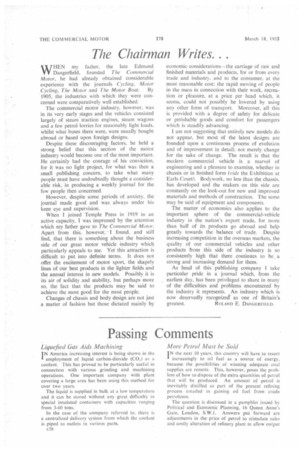The Chairman Writes. . .
Page 78

If you've noticed an error in this article please click here to report it so we can fix it.
WHEN my father, the late Edmund Dangerfield, founded The Commercial Motor, he had already obtained considerable experience with the journals Cycling, Motor Cycling, The Motor and The Motor Boat. By 1905, the industries with which they were concerned were comparatively well established.
The commercial motor industry, however, was in its very early stages and the vehicles consisted largely of steam traction engines, steam wagons and a few petrol lorries for reasonably light loads, whilst what buses there were, were usually bought abroad or based upon foreign designs.
Despite these discouraging factors, he held a strong belief that this section of the motor industry would become one of the most important. He certainly had the courage of his conviction, for it was no light project, for what was then a small publishing concern, to take what many people must have undoubtedly thought a considerable risk, in producing a weekly journal for the few people then concerned.
However, despite some periods of anxiety, the journal made good and was always under his keen eye and supervision.
When I joined Temple Press in 1919 in an active capacity, I was impressed by the attention which my father gave to The Commercial Motor. Apart from this, however, I found, and still find, that there is something about the business side of our great motor vehicle industry which particularly appeals to me. Yet this attraction is difficult to put into definite terms. It does not offer the excitement of motor Sport, the shapely lines of our best products in the lighter fields and the annual interest in new models. Possibly it is its air of solidity and stability, but perhaps more so, the fact that the products may be said to achieve the most good for the most people.
Changes of chassis and body design are not just a matter of fashion but those dictated mainly by economic considerations—the carriage of raw and finished materials and products, for or from every trade and industry, and to the consumer, at the most reasonable cost: the rapid moving of people in the mass in connection with their work, recreation or pleasure, at a price per head which, it seems, could not possibly be lowered by using any other form of transport. Moreover, all this is provided with a degree of safety for delicate or perishable goods and comfort for passengers which is steadily advancing.
I am not suggesting that entirely new models do not appear, but most Of the latest designs are founded upon a continuous process of evolution and of improvement in detail; not merely change for the sake of change. The result is that the modern commercial vehicle is a marvel of engineering and a pleasure to examine, whether in chassis or in finished form (vide the Exhibition at Earls Court). Bodywork, no less than the chassis, has developed and the makers on this side are constantly on the look-out for new and improved materials and methods of construction. The same may be said of equipment and components.
The matter of economics also applies to the important sphere of the commercial-vehicle industry in the nation's export trade, for more than half of its products go abroad and help greatly towards the balance of trade. Despite increasing competition in the overseas markets, the quality of our commercial vehicles and other products from this side of the industry is so consistently high that there continues to be, a strong and increasing demand for them.
As head of this publishing company I take particular pride in a journal which, from the earliest day, has been privileged to share in many of the difficulties and problems encountered by the industry it represents. An industry which is now deservedly recognized as one of Britain's greatest. ROLAND E. DANGERFIELD.








































































































































































































































































